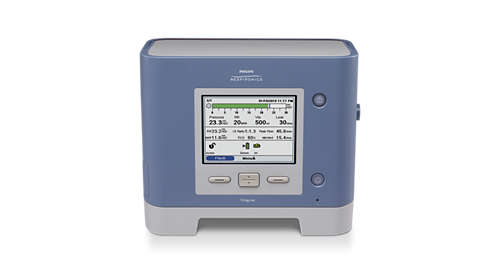
Specifications
-
Controls IPAP -
50 cm H₂O
CPAP -
4 - 20 cmH20 (passive leak port circuits)
EPAP/PEEP (a) -
0 - 25 cmH20 (active valve circuits)
EPAP/PEEP (b) -
4 - 25 cmH20 (passive leak port circuits)
Pressure support -
0 – 30 cmH2O
Tidal volume -
50 - 2000 ml
Breath rate(a) -
0 - 60 BPM (AC mode) bpm
Breath rate(b) -
1 - 60 BPM (all other modes) bpm
Inspiratory time -
0.3 - 5.0 s Synchrony features
Rise time -
1 - 6 (relative scale)
Ramp start pressure (a) -
0 - 25 cmH20 (active circuits)
Ramp start pressure (b) -
4 - 25 cmH20 (passive circuits)
Ramp start pressure (c) -
4 - 19 cmH20 (CPAP mode)
Ramp time -
off, 5 - 45 min
C-Flex -
off, 1 - 3 (relative scale)
Flow trigger sensitivity -
1 - 9 l/min
Flow cycle sensitivity -
10 - 90 %
-
| MPV Mouthpiece Ventilation Mode |
|
|---|---|
| Pressure control (PC) |
|
| Synchronized intermittent mandatory ventilation (SIMV) |
|
| SIMV with pressure support (SIMV w/PS) |
|
| Control ventilation (CV) |
|
| Low tidal volume |
|
|---|---|
| Circuit disconnect |
|
| Apnea |
|
| High tidal volume |
|
| High minute ventilation |
|
| Low minute ventilation |
|
| High respiratory rate |
|
| Low respiratory rate |
|
| Pressure control (PC) |
|
|---|---|
| Pressure control-SIMV (PC-SIMV) |
|
| Spontaneous ventilation (S) |
|
| Spontaneous ventilation with timed back-up (S/T) |
|
| Timed ventilation (T) |
|
| Continuous positive airway pressure (CPAP) |
|
| Average volume assured pressure support (AVAPS) |
|
| Detachable back-up battery |
|
|---|---|
| Hospital roll stand |
|
| DirectView |
|
| Tidal volume |
|
|---|---|
| Minute ventilation |
|
| Estimated leak rate |
|
| Respiratory rate |
|
| Peak inspiratory flow |
|
| Peak inspiratory pressure |
|
| Mean airway pressure |
|
| % patient triggered breaths |
|
| I:E ratio |
|
| Auto-Trak sensitivity |
|
|---|
| FiO2 |
|
|---|---|
| 02 flush |
|
| 02 input pressure range |
|